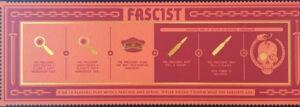For this week’s critical play, I played Secret Hitler. The target audience for this game is a group of 5 to 10 players, such as friends or family. The game is designed by Max Temkin, Mike Boxleiter, and Tommy Maranges from Goat, Wolf, & Cabbage LLC. The game is available in both physical form and online. I played this game physically with other students in the class.
Secret Hitler is a zero-sum competition game between two teams. The game emphasizes social deduction with various mechanics that centers around the asymmetric goals and starting knowledge of the two teams, creating the fun of “fellowship”. One team play as the liberals and the other team play as fascists. The objective of the game is to outwit the other team. For the liberals, the goal is to pass five liberal policies or kill Hitler. For the fascists, the goal is to elect Hitler as Chancellor or pass six fascist policies. In the setup of the game, the liberals do not know the roles of anyone else in the game, while fascists (except Hitler) are able to see the roles of everyone. This setup immediately creates a conflicting dynamic of asymmetric information, where liberals have to deduce the roles of everyone else (most importantly, who is Hitler), while fascists have to work to avoid exposing the identity of Hitler and themselves. The core dynamic is one where liberals want to be open and uncover the truth, while fascists want to blend in or spread misinformation. There are many mechanics during the game to facilitate the social deduction, providing opportunities for liberals to uncover Hitler, and also for fascists to keep their identity hidden.
The most important mechanic is the policy enacting rules. The President selects three policy cards, pass two to the Chancellor who gets to decide which to enact. From the perspective of the liberals, they would like to avoid fascist policies to be passed. Thus, when a fascist policy is passed, this casts suspicion on either the President or Chancellor. However, there is also the possibility that all the policy cards are fascist (a likely possibility as majority of the deck is fascist policies). This provides room for the fascists to defend themselves or to falsely incriminate liberals.
Another important mechanic is the various special powers that enacting fascist policies provide. These include being able to look at the role of another player, or outright assassinating a player. This makes the dynamic more interesting by allowing players to make more actions apart from the standard gameplay loop of voting for chancellor and enacting policy. Fascists may try to assassinate a liberal to tilt the game in their favor. Liberal players may also want to pass fascist policies to gain these special powers. For example, liberals may use the ability to look at the role of another player to gain more information to help with their deduction.

Overall, I think these mechanics of Secret Hitler are very well designed. It creates a balanced environment where both liberals and fascists have a good chance of winning. On one hand, liberals have the numerical advantage and means of uncovering information. On the other hand, fascists are provided with plenty of opportunities to deceive their way to victory.
Compared to other games in the genre, Secret Hitler’s mechanics also extend beyond a standard social deduction game, thus introducing other types of fun. A similar game in this genre is Mafia. Compared to Mafia, the mechanics of Secret Hitler in my opinion creates a better environment for deduction. In particular, I like how Secret Hitler gives the “good” party more tools to deduce the roles of other players. Playing as a villager in Mafia sometimes feels quite boring, because you are at risk of being killed every turn and cannot do much about it, while most of the interesting deduction lies with the detective or doctor. Meanwhile in Secret Hitler, a liberal is able to use logic and the information gained from special powers or policy enactment patterns to deduce roles (for example, when I see two fascist policies passed in a row, it is statistically unlikely so probably someone is lying). This makes the aesthetic of “discovery” more pronounced and accessible in Secret Hitler. Secret Hitler also has a unique setting of pre-WWII Germany and very well made props. This makes the game more immersive and creates the aesthetic of “fantasy”.



